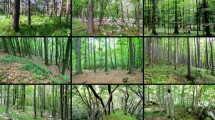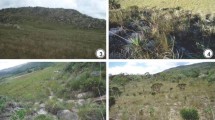Abstract
A recent conceptual model of controls on vegetation structure in semiarid regions includes the hypothesis that the balance between the dominance of woody and herbaceous species is partly controlled by soil texture. The model predicts that the dominance of woody plants is associated with coarse textured soils, and that ecotones between woody and herbaceous plant functional types are associated with soil textural changes. We analyzed vegetation and soil data (from US Soil Conservation Service maps) for an area of shortgrass steppe in Northern Weld County, Colorado, in a canonical correlation procedure to test the hypothesis at a regional scale. In support of the model, we found significant correlations between (a) a canonical vegetation variable correlated with C3 grass biomass and shrub biomass, and a canonical soil variable correlated with sandy topsoils, and (b) a canonical vegetation variable correlated with succulent biomass, and a canonical soil variable correlated with clay soils. Relatively sharp transitions between shrub- and grass-dominated vegetation types occur in a number of areas in the shortgrass steppe of northeastern Colorado and southeastern Wyoming, and we selected four sites to test the above hypothesis at a local scale. We gathered data on vegetation cover and soil texture from transects (50 m long) positioned across the transition zones from grassland to shrubland. We conducted a further canonical correlation analysis of the vegetation and soil data to test for the relationships between vegetation structure and soil texture, and a performed regression analyses on individual site data to describe site-specific relationships between vegetation and soil texture variables. Vegetation structure along the transects, at the level of plant functional types, was similar at all four sites. The transition from grassland to shrubland encompassed a change from a C4 grass/half-shrub complex to a shrub/C3 grass/succulent complex. At two of the sites these transitions were associated with a change to coarser-textured soils in the shrubland zone. Within the context of the shortgrass steppe, our overall findings support the predictions of the conceptual at a regional scale, but indicate that soil texture is only one factor that can influence vegetation structure at the local scale.
Similar content being viewed by others
References
Archer, S. R. 1995. Tree-grass dynamics in a Prosopsis-thornscrub savanna parkland: reconstructing the past and predicting the future. Ecoscience 2(1): 83-99.
Bouyoucos, G. J. 1962. Hydrometer method improved for making particle size analysis of soils. Agron. J. 54: 464-465.
Brown, J. H. 1995. Macroecology. University of Chicago Press, Chicago, IL.
Cosby, B. J., Hornberger, G. M., Clapp, R. B. & Ginn, T. R. 1984. A statistical exploration of the relationships of soil moisture characteristics to the physical properties of soils. Water Resour. Res. 20(6): 682-690.
Crabb, J. A. 1982. Soil Survey of Weld County, Colorado, Northern Part. United States Department of Agriculture - Soil Conservation Service.
Dodd, M. B. 1997. The control of vegetation structure by soil texture effects in the North American shortgrass steppe. Ph.D. dissertation. Department of Rangeland Ecosystem Science, Colorado State University, Fort Collins, CO.
Dodd, M. B. & Lauenroth W. K. 1997. The influence of soil texture on the soil water dynamics and vegetation characteristics of a shortgrass steppe ecosystem. Plant Ecol. 133(1): 13-28.
Dougherty, R. L. 1986. The soil water resource of Opuntia polyacantha in semiarid grassland. Ph.D. dissertation. Department of Range Science, Colorado State University, Fort Collins, CO.
Dougherty, R. L., Lauenroth, W. K. & Singh, J. S. 1996. Response of a grassland cactus to frequency and size of rainfall events in a North American shortgrass steppe. J. Ecol. 84: 177-183.
Ehleringer, J. R. 1978. Implications of quantum yield differences on the distributions of C3 and C4 grasses. Oecologia 31: 255-267.
Fan, W. 1993. Regional analysis of plant species and environmental variables in eastern Colorado. Ph.D. Dissertation. Department of Range Science, Colorado State University, Fort Collins, CO.
Great Plains Flora Association. 1986. Flora of the Great Plains. University Press of Kansas, Lawrence, KS.
Hazlett, D. 1992. Leaf area development of four plant communities in the Colorado Steppe. Am. Midland Nat. 127: 276-289.
Hobbs, E. R. 1986. Characterizing the boundary between California annual grassland and oastal sage scrub with differential profiles. Vegetatio 65: 115-126.
Kinraide, T. B. 1984. The influence of soil texture on the vegetation of a grazed short-grass prairie in Colorado. Southwest. Naturalist 29(3): 277-287.
Lauenroth, W. K. & Milchunas, D. G. 1991. Short-grass steppe. Pp. 183-226. In: Coupland, R. T. (ed.), Ecosystems of the world 8A. Natural grasslands. Elsevier, Amsterdam.
Lawton, J. H. 1996. Patterns in ecology. Oikos 75: 145-147.
Nobel, P. S. 1985. Desert Succulents. Pp. 181-197. In: Chabot, B. F. & Mooney, H. A. (eds), Physiological ecology of North American plant communities. Chapman and Hall, New York.
Ode, D., Tieszen, L. L. & Lerman, J. C. 1980. The seasonal contribution of C3 and C4 plants to primary production in a mixed prairie. Ecology 61: 1304-1311.
Parton, W. J. 1978. Abiotic section of ELM. Pp. 31-53. In: Innis, G.S. (ed.), Grassland simulation model. Ecological studies 26, Springer-Verlag, New York.
Quinn, J. A. & Ward, R. T. 1969. Ecological differentiation in sand dropseed (Sporobolus cryptandrus). Ecol. Mono. 39(1): 61-78.
Sala, O. E. & Lauenroth, W. K. 1982. Small rainfall events: an ecological role in semiarid regions. Oecologia 53: 301-304.
Sala, O. E., Lauenroth, W. K. & Golluscio, R. A. 1997. Plant functional types in temperate semi-arid regions. Pp. 217-233. In: Smith, T. M., Shugart, H. H. & Woodward, F. I. (eds), Plant functional types. Cambridge University Press, Cambridge.
Sala, O. E., Lauenroth, W. K. & Parton, W. J. 1992. Long-term soil water dynamics in the shortgrass steppe. Ecology 73(4): 1175-1181.
Sala, O. E., Lauenroth, W. K. & Reid, C. P. P. 1982. Water relations: a new dimension for niche separation between Bouteloua gracilis and Agropyron smithii in North American semi-arid grasslands. J. Ecol. 19: 647-657.
Sims, P. L., Singh, J. S. 7 Lauenroth, W. K. 1978. The structure and function of ten western North American grasslands I. Abiotic and vegetational characteristics. Journal of Ecology 66: 251-285.
Soil Conservation Service. 1979. Land Use and Natural Plant Communities. Weld County, Colorado. United States Department of Agriculture - Soil Conservation Service.
Spears, C. F., Amen, A. E., Fletcher, C. A. & Healey, C. R. 1968. Soil Survey of Morgan County, Colorado. United States Department of Agriculture, Soil Conservation Service.
Squires, V. R. 1979. The biology of Australian weeds. 1. Tribulus terrestris L. J. Aust. Inst. Agric. Sci. 45(2): 75-82.
Stevenson, A., Lloyd, M. D. & Joseph, L. 1983. Soil Survey of Laramie County, Wyoming, Eastern Part. United States Department of Agriculture, Soil Conservation Service.
Sturges, D. L. 1977. Snow accumulation and melt in sprayed and undisturbed big sagebrush vegetation. Research Note RM-348. United States Department of Agriculture, Forest Service.
Teeri, J. A. & Stowe, L. G. 1976. Climatic patterns and the distribution of C4 grasses in North America. Oecologia 23: 1-12.
Turner, G. T. & Costello D. F. 1942. Ecological aspects of the pricklypear problem in eastern Colorado and Wyoming. Ecology 23: 419-426.
Walter, H. 1979. Vegetation of the earth, 2nd edition. Springer-Verlag, New York.
Weaver, J. E. 1968. Prairie plants and their environment. University of Nebraska Press, Lincoln, NE.
Weiner, J. 1995. On the practice of ecology. J. Ecol. 83: 153-158.
West, N. E. 1988. Intermountain deserts, shrub steppes, and woodlands. Pp. 209-230. In: Barbour, M. G. & Billings, W. D. (eds), North American terrestrial vegetation. Cambridge University Press, New York.
Author information
Authors and Affiliations
Rights and permissions
About this article
Cite this article
Dodd, M., Lauenroth, W., Burke, I. et al. Associations between vegetation patterns and soil texture in the shortgrass steppe. Plant Ecology 158, 127–137 (2002). https://doi.org/10.1023/A:1015525303754
Issue Date:
DOI: https://doi.org/10.1023/A:1015525303754




